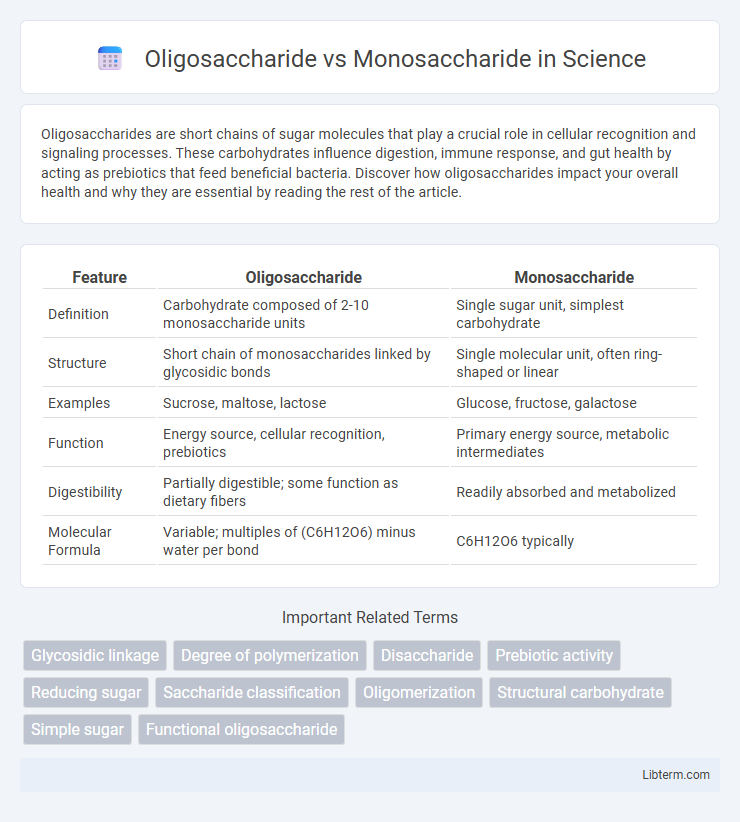Oligosaccharides are short chains of sugar molecules that play a crucial role in cellular recognition and signaling processes. These carbohydrates influence digestion, immune response, and gut health by acting as prebiotics that feed beneficial bacteria. Discover how oligosaccharides impact your overall health and why they are essential by reading the rest of the article.
Table of Comparison
| Feature | Oligosaccharide | Monosaccharide |
|---|---|---|
| Definition | Carbohydrate composed of 2-10 monosaccharide units | Single sugar unit, simplest carbohydrate |
| Structure | Short chain of monosaccharides linked by glycosidic bonds | Single molecular unit, often ring-shaped or linear |
| Examples | Sucrose, maltose, lactose | Glucose, fructose, galactose |
| Function | Energy source, cellular recognition, prebiotics | Primary energy source, metabolic intermediates |
| Digestibility | Partially digestible; some function as dietary fibers | Readily absorbed and metabolized |
| Molecular Formula | Variable; multiples of (C6H12O6) minus water per bond | C6H12O6 typically |
Introduction to Carbohydrates
Oligosaccharides consist of short chains of 3 to 10 monosaccharide units linked by glycosidic bonds, playing crucial roles in cell recognition and signaling. Monosaccharides, such as glucose, fructose, and galactose, are the simplest carbohydrates and serve as fundamental energy sources and building blocks for complex carbohydrates. Both oligosaccharides and monosaccharides contribute to structural diversity and biological functionality within the carbohydrate family.
What Are Monosaccharides?
Monosaccharides are the simplest form of carbohydrates, consisting of a single sugar molecule with the general formula (CH2O)n. Common examples include glucose, fructose, and galactose, which serve as essential energy sources in cellular metabolism and building blocks for more complex carbohydrates. Unlike oligosaccharides, which contain two to ten monosaccharide units linked together, monosaccharides cannot be hydrolyzed into simpler sugars.
What Are Oligosaccharides?
Oligosaccharides are carbohydrates composed of 3 to 10 monosaccharide units linked by glycosidic bonds, serving as intermediate structures between monosaccharides and polysaccharides. These complex sugars play crucial roles in cellular recognition, signaling, and digestion, often found in foods such as legumes, onions, and garlic. Unlike monosaccharides, which are single sugar molecules like glucose and fructose, oligosaccharides contribute to prebiotic activity by promoting beneficial gut bacteria growth.
Structural Differences: Monosaccharides vs Oligosaccharides
Monosaccharides are the simplest carbohydrates consisting of a single sugar unit with a basic molecular formula (CH2O)n, typically containing three to seven carbon atoms arranged in a linear or cyclic structure. Oligosaccharides are composed of two to ten monosaccharide units linked by glycosidic bonds, creating more complex structures that can branch or form linear chains. The structural complexity of oligosaccharides leads to diverse biological roles in cell recognition, signaling, and immune response, contrasting with the fundamental energy-providing function of monosaccharides.
Natural Sources of Monosaccharides and Oligosaccharides
Monosaccharides, such as glucose, fructose, and galactose, are naturally found in fruits, honey, and dairy products, serving as primary energy sources for the body. Oligosaccharides, including raffinose and stachyose, are commonly present in legumes, whole grains, and certain vegetables like onions and garlic, where they contribute to digestive health by promoting beneficial gut bacteria. Both types of carbohydrates play essential roles in nutrition, with monosaccharides being readily absorbed and oligosaccharides functioning as prebiotic fibers.
Biological Functions and Roles
Oligosaccharides serve as key recognition and signaling molecules in cellular communication and immune responses, while monosaccharides primarily provide immediate energy through glycolysis and serve as fundamental building blocks for complex carbohydrates. Oligosaccharides also contribute to cell adhesion and differentiation processes, whereas monosaccharides are critical in metabolic pathways such as the pentose phosphate pathway. Both types of carbohydrates play essential roles in maintaining cellular structure and function, with oligosaccharides often involved in extracellular interactions and monosaccharides focused on intracellular energy metabolism.
Digestion and Absorption Mechanisms
Oligosaccharides undergo partial digestion by enzymes like a-galactosidase in the small intestine before reaching the colon, where gut microbiota ferment them, producing short-chain fatty acids beneficial for gut health. Monosaccharides, such as glucose and fructose, are absorbed directly across the intestinal epithelium through specific transporters like SGLT1 and GLUT5, entering the bloodstream rapidly for immediate energy use. The distinct enzymatic breakdown and absorption pathways determine their metabolic impact and physiological roles in human nutrition.
Health Impacts and Nutritional Benefits
Oligosaccharides, composed of short chains of monosaccharides, function as prebiotics that promote gut health by stimulating beneficial bacteria growth, enhancing immune function, and improving digestive processes. Monosaccharides, such as glucose and fructose, provide immediate energy but excessive intake can lead to blood sugar spikes and metabolic issues. Incorporating oligosaccharides in the diet supports long-term gut microbiota balance and overall metabolic health, while monosaccharides serve as quick energy sources essential for cellular function.
Applications in Food and Industry
Oligosaccharides, comprised of 3 to 10 monosaccharide units, are widely used as prebiotic ingredients in functional foods, promoting gut health by selectively stimulating beneficial bacteria. Monosaccharides, such as glucose and fructose, serve as fundamental energy sources and key substrates in fermentation processes for producing bioethanol, sweeteners, and flavor enhancers in food and industrial applications. Both oligosaccharides and monosaccharides are essential in formulating low-calorie and sugar-free products, contributing to innovations in health-conscious food manufacturing.
Key Differences Summarized: Oligosaccharide vs Monosaccharide
Oligosaccharides are carbohydrates composed of 3 to 10 monosaccharide units linked by glycosidic bonds, while monosaccharides are the simplest sugars consisting of a single sugar unit like glucose or fructose. Oligosaccharides play a role in cell recognition and signaling, often found in dietary fiber and prebiotics, whereas monosaccharides serve as primary energy sources metabolized during cellular respiration. The structural complexity and functional diversity distinguish oligosaccharides from the basic energy-yielding monosaccharides in biological systems.
Oligosaccharide Infographic

 libterm.com
libterm.com